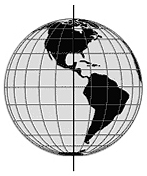|
The sun: our most powerful neighborOur largest neighbor, the sun, has a tremendous impact on the earth. Most of Earth's energy is drawn from the sun. The heat and light of the sun reach Earth and provide solar energy. Solar energy affects weather and all types of life. There are three relationships between the earth and the sun that determine how much solar energy is received at various locations on Earth. Let's look at all three. RotationAs you know, rotation refers to the spinning of a planet on its axis. One complete turn is called a rotation; one Earth rotation takes twenty-four hours. From our perspective it looks like the sun is moving across the sky, and that is exactly what early humans thought happened. Now we know that the movement of the sun across the sky is caused by the earth's rotation. The earth rotates west-to-east, so the sun appears to rise in the east and set in the west. As the earth turns, the sun shines on about one-half of the earth, creating day, with the remainder of the earth experiencing night. If the rotation did not occur and the same side of the earth always faced the sun, that side of the earth would become incredibly hot. The side of the earth that would be facing away from the sun would be perpetually dark and very cold. RevolutionWhile the earth is rotating, it also revolves around the sun, which means that it circles the sun. Earth's orbit isn't really a circle; instead, it is elliptical, which is another way of saying it is oval. It takes 365 ¼ days for Earth to complete its trip around the sun. You might wonder about that extra ¼ day. The way we deal with it is to ignore it for three years, and then on the fourth year we add an extra day to our calendar, so we have twenty-nine days in the month of February that year, instead of the normal twenty-eight days. When this happens we call it a “leap” year.
The rod represents the earth's axis. If the axis always pointed straight up and down in relationship to the sun, then no matter where you were on the earth every day would last exactly twelve hours and every night would last exactly twelve hours. However, the earth's axis does not point straight up and down in relationship to the sun; instead, it points directly at a star called the North Star. This means that sometimes the North Pole points towards the sun and sometimes it points away from the sun. As Earth revolves around the sun, it is tilted on its orbit as shown in the animation below. Because of the tilt, different areas of the earth receive different amounts of sunlight, or solar energy, during the year. The amount of solar energy that any location of the earth receives also depends on where the earth is in its orbit and in its rotation. Use the animation below to watch the earth's orbit around the sun.
 
|
About Us | Terms of Use | Contact Us | Partner with Us | Press Release | Sitemap | Disclaimer | Privacy Policy
©1999-2011 OpenLearningWorld . com - All Rights Reserved


